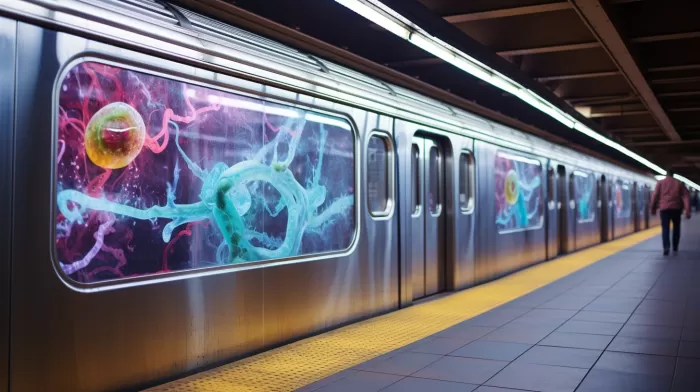Next time you step onto a subway platform, you might want to ponder this fact: There’s a whole world of microbial life buzzing around. Just recently, a study uncovered the germs and organisms living beneath the city streets in New York’s subways, including bacteria and DNA evidence of anthrax and Bubonic plague! Although these findings might at first glance leave you feeling a little uneasy, take comfort in knowing that the vast majority of these germs are harmless and some may even be helpful. Let’s dive deeper into this underground world and learn more about the microbe jungle that lurks beneath our feet.
The Subway Microbiome
A team of researchers from Weill Cornell Medical College set out to develop what they call a pathogen map (patho-map) of urban areas. To achieve this, they collected numerous samples of the microbiomes scattered throughout New York City’s transit system. Out of the 637 different types of bacteria, viruses, fungi, and other life forms they found, most were harmless and could even be categorized as beneficial.
Dr. Christopher Mason, one of the researchers, explains: “Our data show evidence that most bacteria in these densely populated, highly trafficked transit areas are neutral to human health, and much of it is commonly found on the skin or in the gastrointestinal tract. These bacteria may even be helpful since they can out-compete any dangerous bacteria.” It goes without saying that some bacteria are always going to be present in such a heavily used environment like subways. In most cases, these bacteria don’t pose any significant risk to human health.
Don’t worry, viruses aren’t as common as you might think. The researchers found that the vast majority of organisms they discovered (46.9%) consisted of bacteria, while viruses surprisingly made up only a minuscule 0.032% of the samples.
What About Those Drug-Resistant Pathogens?
While most microorganisms found in the subway system were harmless, researchers still identified some concerning findings. Several samples contained drug-resistant bacteria, as well as DNA evidence of anthrax and Bubonic plague. However, the levels of these substances were extremely low, and lab tests found no signs of living organisms that could pose a threat to human health.
Dr. Mason believes that the microbes they found are not a significant health concern. Instead, they are part of the shared urban infrastructure and city environment: “Despite finding traces of pathogenic microbes, their presence isn’t substantial enough to pose a threat to human health.” More tests will be needed to determine how common these organisms are in other cities, but for now, there’s no need to panic.
The Importance of a Pathogen Map
The main goal of a pathogen map is to provide essential information for disease surveillance, bioterrorism monitoring, and public health management in urban centers. By frequently collecting and analyzing samples from a city’s microbiome, researchers can detect potentially harmful outbreaks or even prevent them from occurring in the first place.
For example, if the number of drug-resistant bacteria in subway samples suddenly shows an increase, this data could prompt a swift response from health authorities, helping to contain the spread before it becomes a significant threat. In this way, a pathogen map acts as both an early warning system and a valuable source of information for managing urban health and safety.
Living with Our Microbial Neighbors
As we share our busy urban lives with millions of other people, it’s no surprise that we also share our environment with a wide range of microscopic organisms. While it might not be the most pleasant thing to think about, it’s essential to remember that these germs are simply part of life in the big city.
Most of these tiny microbes coexist alongside us without causing any harm, and some even serve a beneficial role in maintaining the delicate balance of our urban ecosystem. The development of pathogen maps will hopefully provide a greater understanding of the microbial communities beneath our city streets and aid in keeping our urban environments as safe and healthy as possible. So next time you step onto a subway platform, take a moment to appreciate the fascinating invisible world hidden just below the surface.



